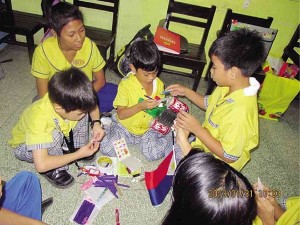Nurturing enterprising children
“Kung anong kinamulatan, siya ring pagkakatandaan” (Whatever you grew up with will be with you until old age).
This folk saying underlies the BEST project of the Small Enterprises Research and Development Foundation (Serdef). BEST stands for Building an Enterprising Society Today, an enterprise education program for children at pre- and grade-school levels.
For many years now, entrepreneurship promotion has focused mostly on developing adult entrepreneurs through various means: training, provision of business support services, and entrepreneurship education at college level.
To this day, however, there is no clear indication these efforts actually foster entrepreneurial values which could spawn a society of risk-takers, innovators and achievers. Rather, what was learned from experience was that it might be best to inculcate entrepreneurial values in the early formative years when the human mind is at its most impressionable and malleable.
‘BEST’ learned early
To confirm this premise, Serdef is pilot-testing the BEST program in two private schools: the Old Balara Christian School (OBCS) and the Roosevelt College System Rodriguez Elementary School.
Located in the heart of urban poor communities in Quezon City, the OBCS has for some time now been deliberately inculcating entrepreneurship across its curriculum from pre-school until high school. The BEST project aims to determine whether the entrepreneurship-oriented educational intervention in the school is indeed producing enterprising mindsets by tracking the students’ progress in time.
For purposes of comparison, one section each of kindergarten and Grade 1 learners at the Roosevelt Elementary School in Rodriguez, Rizal are also being tracked. Although like OBCS, the basic framework of Roosevelt school’s curriculum is the K-12 education program, Roosevelt does not have a curriculum geared specifically to entrepreneurship.
Besides risk-taking, innovativeness and achievement orientation, there are ten values that BEST infuses in learners. These are: mabunga (productive), may hiya (ethical), masigasig (persistent), mahusay (excellent), malikhain (creative), mapagpakumbaba (realistic view of oneself), maagap sa oportunidad (opportunity seeking), may pagpapahalga sa oras (time-disciplined), may pagkukusa (initiative) and mapagmahal sa komunidad at bayan (love of community and country).
Fusion of old and new
The entrepreneurship-enriched curriculum seeks to fuse two learning settings: the traditional, formal school culture and the new informal, enterprising culture. While the former is hierarchical, orderly and predictable, the latter is free, intuitive and creative. In the traditional setting, students are expected to follow school-imposed procedures while in an enterprising environment, students can sometimes “do it their way.” Learning modes differ too: enterprise education is predominantly learning by doing, the other is basically rote learning.
Learning by doing is achieved through the adoption of non-traditional, experiential learning activities like “producing” items (mostly toys) to stimulate the learners’ creative problem-solving skills, exposure to business operations through visits to malls, and reading and hearing success stories of some of the top entrepreneurs in the Philippines, particularly those in businesses that the kids easily relate to, such as the fast-food business.
The students also organize market fairs where they sell items – usually food—that they made at home with the help of their parents. These activities expose them to actual business operations, including calculating prices and how to sell products for a profit. Students are also exposed to the current concerns on environment protection through sessions where they collect recyclable waste materials and sell them to junk shops around the school.
Community involvement
The BEST process does not stop with learners. Teachers themselves hone their knowledge on entrepreneurship through seminars and brainstorming sessions on teaching methods to adopt for entrepreneurial values formation. Additionally, the students’ families and the community where they live and where the schools are located participate as sources of knowledge and assistance in entrepreneurship activities.
BEST is aligned with the K-12 program’s goals of raising the skill level of the Filipino workforce and preparing students as lifelong learners equipped to create jobs or excel in workplaces.
Ultimately, BEST aims to prove that the benefits from entrepreneurship go beyond economic considerations. More than just business creation, enterprise education also fosters a mindset which covers a gamut of attitudes and values considered enterprising—a very important attribute for the formation of an enterprising society as a whole.
(The author is a trustee of the Small Enterprises Research and Development Foundation. For more stories and articles on entrepreneurship visit the Serdef website at www.serdef.org.)
